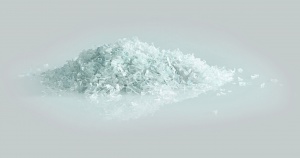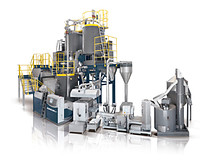Vacurema technology

Erema's Vacurema systems offer modular approaches for different solutions of PET bottle recycling. The patented process is designed for the recycling of post consumer PET bottle flakes, PET in-house waste and also PE-HD bottle flakes. Vacurema technology was first launched in 1998.
Erema claims that there are currently more than 150 Vacurema systems in use around the world, producing high-quality pellets and end products with an overall capacity of over 1 million tonnes.
Vacurema technology is designed for purposes of
- PET pelletising
- PET inline (strapping, film, fibre)
Erema offers a complete inline production line for film which consists of a Vacurema Basic extrusion system plus a downstream processing step for thermoforming film production. The system is designed to process 100% bottle flakes, ground amorphous skeleton waste, virgin material, edge trim and mixtures of them directly to make food-contact compliant single-layer films (FDA conformity in accordance with categories A-H/J, EFSA approval requested via customers and obtained). In addition to this the Vacurema extruder can be combined with film production lines of many downstream system suppliers. This enables direct production of high-quality end products without pelletising.
- PET bottle-to-bottle applications
Basic principles
In the Vacurema process, food contact compliant decontamination takes place before the extrusion process. The patented pre-treatment of PET flakes at raised temperature and in high vacuum before the extrusion process removes moisture and migration materials from the feedstock very effectively and in a stable process environment. Thanks to the vacuum treatment, stable IV values can be achieved even in the case of varying moisture levels and different IV values in the input material.
Flexibility with input material Input materials with up to 1.5% moisture can be processed, no expensive pre-drying is necessary- Extruder degassing is not required either, meaning that a short extruder screw can be used and the thermal stress on the material is reduced as a result. Depending on the end application the system processes PET bottle flakes, ground amorphous skeleton waste/edge trim and virgin material (also in mixtures), i.e. bulk densities of 250 to 850kg/m³.
Decontamination - ready for foodcontact Thanks to the patented pre-treatment of PET flakes, IV increase and decontamination are fast, reliable and energy-saving. The parameters for direct food contact compliance are automatically monitored and archived continuously in the recycling process on all VACUREMA systems. Food Contact Control (FCC) supervises the recipe data stored. This enables the flexible change to the process parameters required for the production of the respective recyclate. If levels go beyond defined limits an alarm is triggered automatically and (optionally) material flow is diverted away from the production line. This means that FDA quality (among other things) can be ensured for the end products produced. Surface to volume ratio for flakes is 2.5 times higher than for pellets-
- Bottle flakes Pre-ground with 12mm screen, average wall thickness approx. 0.1 to 0.4mm
- Pellets: Typical dimensions: diameter approx. 2.5mm x 3mm length or ball shap
IV stability through vacuum treatment Despite varying moisture levels and different IV values in the input material, stable IV values are achieved through the patented pre-treatment method. This means, that input materials with higher material moisture levels can also be recycled.
Melting under vacuum The patented pre-treatment at raised temperature and in high vacuum before the extrusion process removes moisture and migration materials from the feedstock in a stable process environment. This prevents any hydrolytic and oxidative decomposition of the melt in the extruder.
Low thermal stress The very short extruder screw without additional extruder degassing reduces the thermal stress on the material through minimized dwell time.
Large area ultrafine melt filtration The filter systems have very large active filter surfaces. This enables filtration with up to 32μm fineness at low pressure. The result is highly clean pellets.
Energy savings Vacurema technology feature ecoSAVE technology, which was developed especially to ensure high energy-efficiency levels. It is a complete design and process engineering package that includes a variety of energy-saving components and high-performance motors.
Smart Start principle The plant‘s software-based process control system gives you extremely easy and reliable operation and premium user-friendliness including automatic start-up at the press of a button, fully automatic continuous operation, permanent monitoring for direct food contact (FCC) and the storage of all relevant process parameters.
Turnkey solutions Erema delivers turnkey systems with support from one contact for the entire recycling process: sorting – washing – decontamination – extrusion – quality control – end product.
Three systems
Vacurema Basic
The system consists in its key components of a vacuum reactor which is linked directly to a single-screw extruder. The vacuum reactor unit is filled with amorphous, washed PET flakes via a vacuum lock. Decontamination and pre-drying of the processed material take place inside the vacuum reactor. From the reactor the material is fed at a high vacuum into the intake zone of the single-screw extruder. As a result no additional degassing ports are required on the extruder itself. This means that the Vacurema technology reduces the length of the extruder, reduces its energy consumption , improves colour values (b value) of the processed material and keeps AA values to a very low level. In the downstream high-performance fine filter the material is filtered with a 32μm mesh screen width . The filter system is equipped with a patented fully automatic self-cleaning system that enables long filter service life. The now finished melt is then passed on to the downstream process for the production of end products such as fibres, strapping, thermoforming sheet or amorphous or crystalline pellets.
Vacurema Basic has become established in the field of so-called inline production systems. PET secondary raw materials such as bottle flakes, ground amorphous skeleton waste, virgin material, edge trim and mixtures of them with virgin material are recycled directly to make end products such as FDA approved and ILSI compliant thermoforming sheet and even fibres and strapping. Vacurema Basic is also used for the production of bottle-to-bottle compliant, ultra-fine filtered repellets. Vacurema Basic systems can be retrofitted if required to upgrade to a full Vacurema Advanced or Vacurema Prime high-end system.
Vacurema Advanced
Vacurema Advanced extrusion system is the first expansion stage of the Vacurema Basic technology. Building on the Vacurema Basic system, it features an additional, continuously operating upstream vacuum crystallisation dryer. In the process from flake to r-pellets, IV increases of around 4 to 6% can be achieved. As a result the system is interesting for the bottle-to-bottle application field. It can be upgraded at any time to Vacurema Prime.

Vacurema Prime
The system is designed for production of decontaminated, pre-dried and crystallised rPET flakes and high-quality, melt-filtered rPET pellets. The products fulfil the respective criteria of the FDA, EFSA and many major brand owners. If IV values of > 0.9 dl/g or very high throughputs (> 2500kg/h) are required, Erema can offer Vacurema technology also in combination with an SSP solution from a global supplier. This high-end PET extrusion system for bottle-to-bottle applications features two parallel crystallisation dryers operating in batch mode. The dryers are each filled with amorphous, washed PET flakes via a vacuum lock. The high level of purity of the rPET that is achieved by an exactly defined and guaranteed minimum treatment time for every single thin-walled PET flake in high vacuum and at high temperature. Purity and IV requirements placed on the end product (rPET pellets) can be adapted individually by selecting appropriate batch times.
References
Related articles
Vacurema: rPET for direct food contact